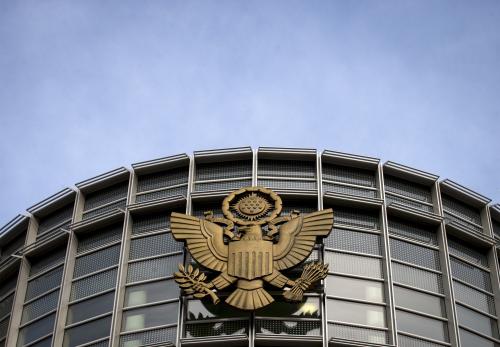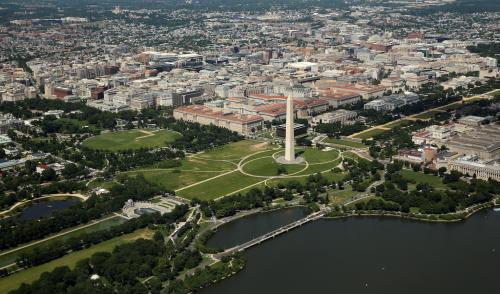A sideshow to May 15’s oral argument: before a panel of Ninth Circuit appellate judges about the administration’s revised travel ban is President Trump’s running attack on what one pre-argument headline called “the federal appeals court that Trump hates the most.”
Trump wants to “break up the Ninth Circuit” because six of its judges so far have stayed enforcement of some of his executive orders. “You see judge shopping,” he complained after a recent decision.” [T]hey immediately run to the Ninth Circuit . . . It’s got close to an 80 percent reversal period [sic].” The president appears to have glommed on to a favorite conservative talking point—getting rid of the Ninth circuit—with little apparent understanding of what it would accomplish.
The nine-state, two-territory Ninth circuit stretches north from Arizona through Montana to Alaska and west to the coast and out to Hawaii and two Pacific territories. It has 15 district courts and a 29 judgeship court of appeals, 12 more than the next largest court. Trump’s “80 percent reversal period [sic]” reference suggests that his main object is the court of appeals, even though that outburst followed a district judge’s decision. In any event, others (e.g., here, here, and here) have put the 80% claim into context. As to criticizing plaintiffs for “immediately run[ning] to the Ninth Circuit,” in fact suits against Trump’s travel bans have been filed in districts in ten of the 12 regional circuits. And regardless, seeking favorable venues is responsible advocacy. It’s why opponents of Obama’s policies challenged them in Texas federal courts.
The basic reason Trump wants to break up courts in the Ninth circuit is because he’s mad at their judges. A 1998 report of a statutory commission appointed by Chief Justice William Rehnquist to assess appellate structural alternatives reminds us that “It is wrong to realign circuits … or to restructure courts …because of particular judicial decisions or particular judges. This rule must be faithfully honored, for the independence of the judiciary is of constitutional dimension and requires no less.” (Disclaimer: I worked on the report while at the Federal Judicial Center.)
Calls to divide the Ninth circuit and its appellate court have been around since the 1930s. This year, legislators mainly from Ninth circuit states other than California have introduced five restructuring bills. One would reduce the Ninth circuit to California only. Two would add, Hawaii and the Pacific territories to a circuit with California. One would add Oregon to that group, another Oregon and Washington. All would move the rest into a new 12th circuit, with its own court of appeals.
The bills’ sponsors argue that the circuit is too large and the court’s caseload too big to allow litigants “swift justice” and that the court is out of touch with the inter-mountain states. All but one were introduced before Seattle District Judge James Robart issued the first of the rulings that have bedeviled Trump, who has apparently endorsed none of them. Nevertheless, they offer a way to assess whether a break-up would get Trump what he wants—appellate courts with different ideological complexions.
Here’s the array of active-status judges on the current court and on restructured courts if the current court’s California, Hawaii, and Oregon-based judges comprised the new Ninth circuit appellate court (i.e. the structure in the Flake- McCain bill). The table thus illustrates one possible reconfiguration.)
| D-appointees | R-Appointees* | Total | |||||
|---|---|---|---|---|---|---|---|
| Current Ninth | 18 | 11 | 29 | ||||
| New Ninth | 11 | 8 | 19 | ||||
| New Twelfth | 7 | 3 | 10 | ||||
| *As if the four current vacancies had been filled with Trump appointees. | |||||||
Party-of-appointing-president is a loose but far from a certain predictor of decisional tendencies. The six Ninth circuit district and circuit judges who have ruled against the administration so far include four Democratic and two Republican appointees. But when the full court of appeals voted 20-5 against having the court review the panel’s decision, the five dissenters were all Republican appointees (who nevertheless called Trump’s criticism of the judges “out of all bounds of civic and persuasive discourse”). So, party-of-appointing president is a reasonable but hardly iron-clad shorthand surrogate for a more-likely-than-not approval or disapproval of Trump’s proposals. (And we’re looking here only at active-status judges, even though senior and visiting district judges sometimes serve on appellate panels.)
Even with these caveats, the bills on the table would do little to serve Trump’s decision-oriented goals. The restructured Ninth circuit appellate court’s 19 judgeships would still be the largest of the U.S. courts of appeals. The 60% plus majority Democratic appointees will have on the current court once Trump fills four vacancies would be reduced only slightly on a restructured court. Trump might have some opportunity for more appointments, but he likely could not get a Republican-appointee majority at least for a while, given that four of the ten Democratic-appointees on what would be the new Ninth court are aged 51 or younger and older circuit judges tend to stay in active status well past their eligibility to leave it.
And for the foreseeable future, the district judges generating appeals would include many Democratic appointees. Seventy-one life-tenured district judgeships would be in the California- Hawaii-Oregon Ninth circuit—ten percent of district judgeships nationwide. Of the 63 sitting judges (eight seats are or soon will be vacant), 38 are Democratic appointees, including 31 Obama appointees, who are likely to be around for a while.
Although Trump appointees over the next four or eight years would reduce the Democratic-Republican appointee gap on the new courts, they would do that to the current court as well. And any new balance would not guarantee Trump-friendly decisions, in part because Democratic senators Feinstein and Harris will probably have a say in future nominations, and, anyway, few judges adhere to a strict party line.
Finally, a 19 judgeship appellate court with 16 of them based in California risks insularity, lacking the benefit of perspectives of judges from other parts of the west.
Rather than bow to hasty analysis—or worse yet, to Trump’s anger at judges—if Congress is genuinely concerned about the operation of the Ninth circuit’s court of appeals, it should consider Republican Senators Daines’ (MT) and Sullivan’s (AK) bill, a near-verbatim version of the statute that created the 1998 Rehnquist-appointed commission (which recommended restructuring the court but not the circuit). And, if Congress creates the new commission and it does its job objectively, as did the earlier commission, Congress should pay attention to its conclusions.










Commentary
Trump wants to “break up the Ninth Circuit.” How would that help him?
May 16, 2017